OTP Authentication
- Introduction
- How it works?
- Configuring Connectors in SigningHub Admin
- Service Plan Configuration in SigningHub Admin
- Authentication via One Time Password (OTP) and Time based One Time Password (TOTP)
OTP stands for "One-Time Password," and TOTP stands for "Time-based One-Time Password." Both are authentication methods that provide an additional layer of security beyond traditional passwords. In essence, OTPs, including TOTPs, are dynamic and time-sensitive, providing an effective means of securing digital accounts and transactions. When the documents are shared on the web with other users, it's important to upscale the security levels for preventing fraudulent attempts and bad actors compromising your document security. SigningHub provides you with an option to configure One Time Password (OTP) and Time based One Time Password (TOTP) for login authentication, document opening authentication, and document signing authentication.
- Configure the SMS and Email connectors, in SigningHub Admin.
- Configure OTP and TOTP against your service plan, in SigningHub Admin.
- Authentication via One Time Password (OTP) and Time based One Time Password (TOTP)
- Login Authentication
- Document Access Authentication
- Document Signing Authentication
- Signing Server-level Authentication
- Recipient Permission-level Authentication
- Field-level Authentication
- OTP preference
Configuring Connectors in SigningHub Admin
Configure the "SMS Gateway" connector to be used for sending SMS OTPs, and the "Email Gateway" connector to be used for sending Email OTPs.
- Configure an SMS Connector
To see in detail, how to create a Twilio Connector in SigningHub, click here. (Alternatively, either the Generic SMS connector, or the Clickatell connector could also be used.)
Make the following configurations to a connector in SigningHub Admin:
- In the "Basic Information" section, choose "Twilio" as the "Provider".
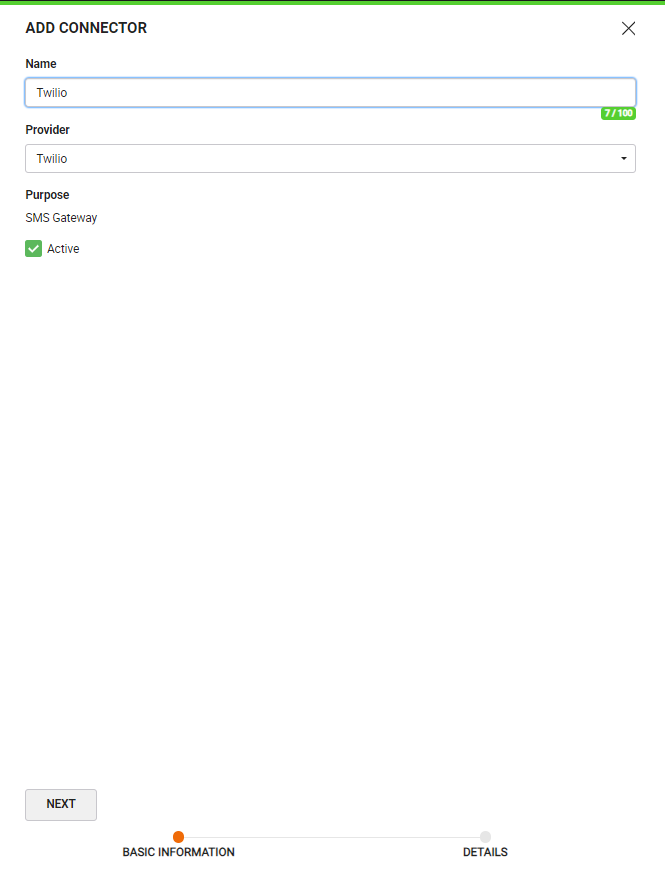
- In the "Details" section, fill in the required fields.

- Configure an Email Connector
To see in detail, how to create an SMTP Server Connector in SigningHub, click here.
Make the following configurations to a connector in SigningHub Admin:
- In the "Basic Information" section, choose "SMTP Server" as the "Provider".

- In the "Details" section, fill in the required fields.
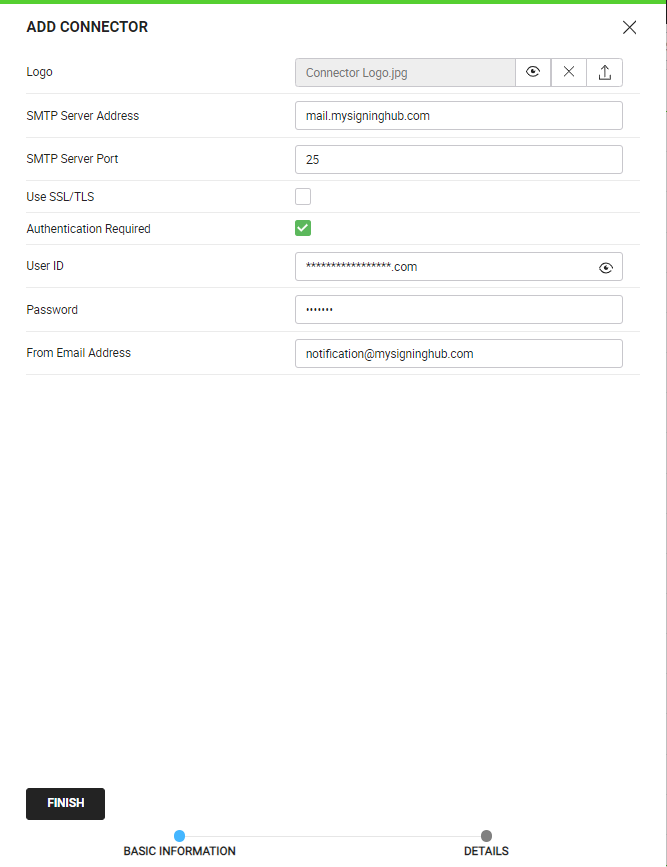
Service Plan Configuration in SigningHub Admin
To see in detail, how to create a new service plan in SigningHub, click here.
Make the following configurations against the service plan.
- From the Settings screen, check the "Enable One Time Password (OTP)" and the "Enable Time based One Time Password (TOTP)" checkboxes, as required.
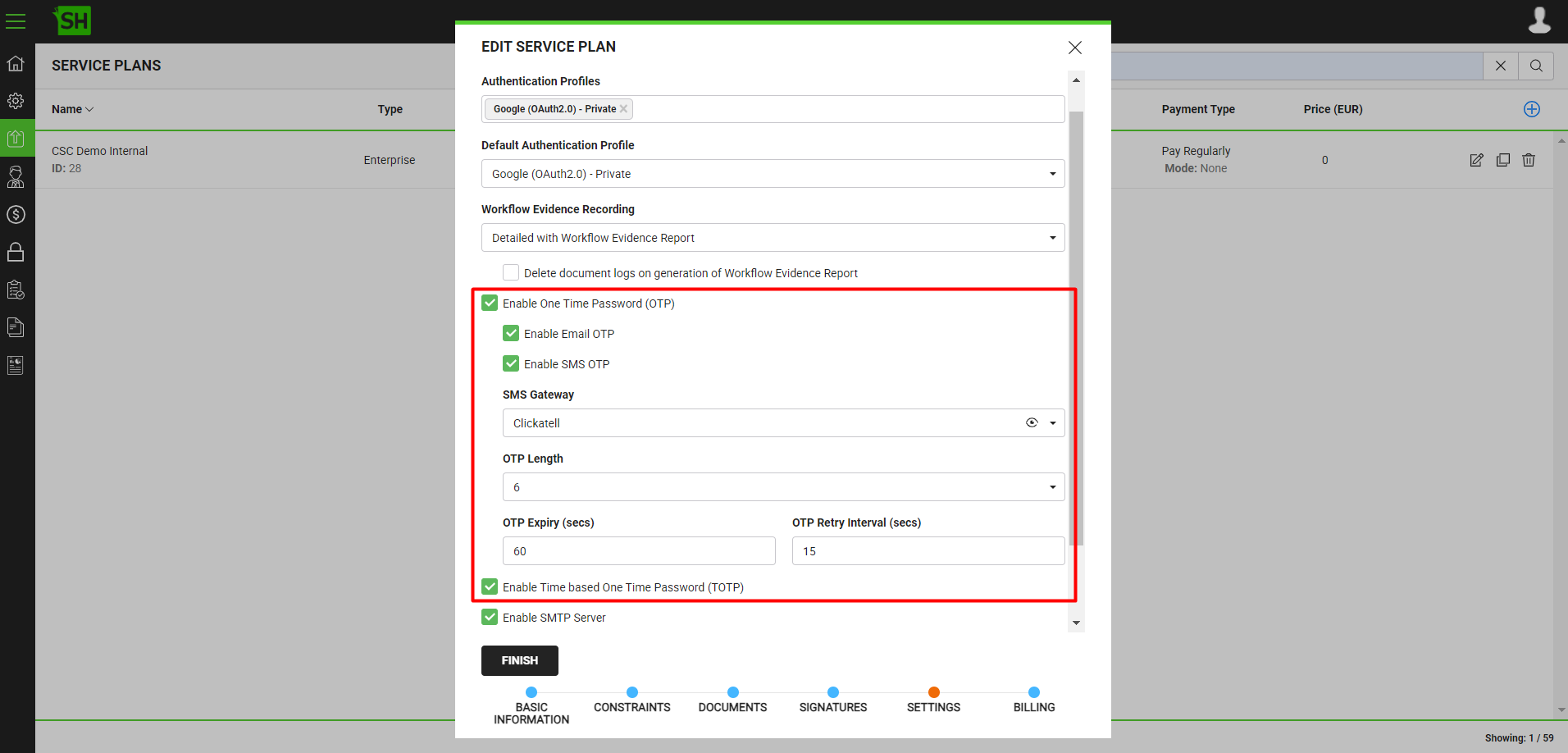
Authentication via One Time Password (OTP) and Time based One Time Password (TOTP)
One Time Password (OTP) and Time based One Time Password (TOTP) can be used for login authentication, document access authentication, and document signing authentication.
- Login Authentication
- Configuration:
To see in detail, how to configure a secondary authentication method for login in SigningHub, click here.
Make the following configurations to the user role settings SigningHub Web:
- In the "Login Authentication" tab, choose either "One Time Password" or "Time based One Time Password (TOTP)" as the "Secondary Authentication Method".
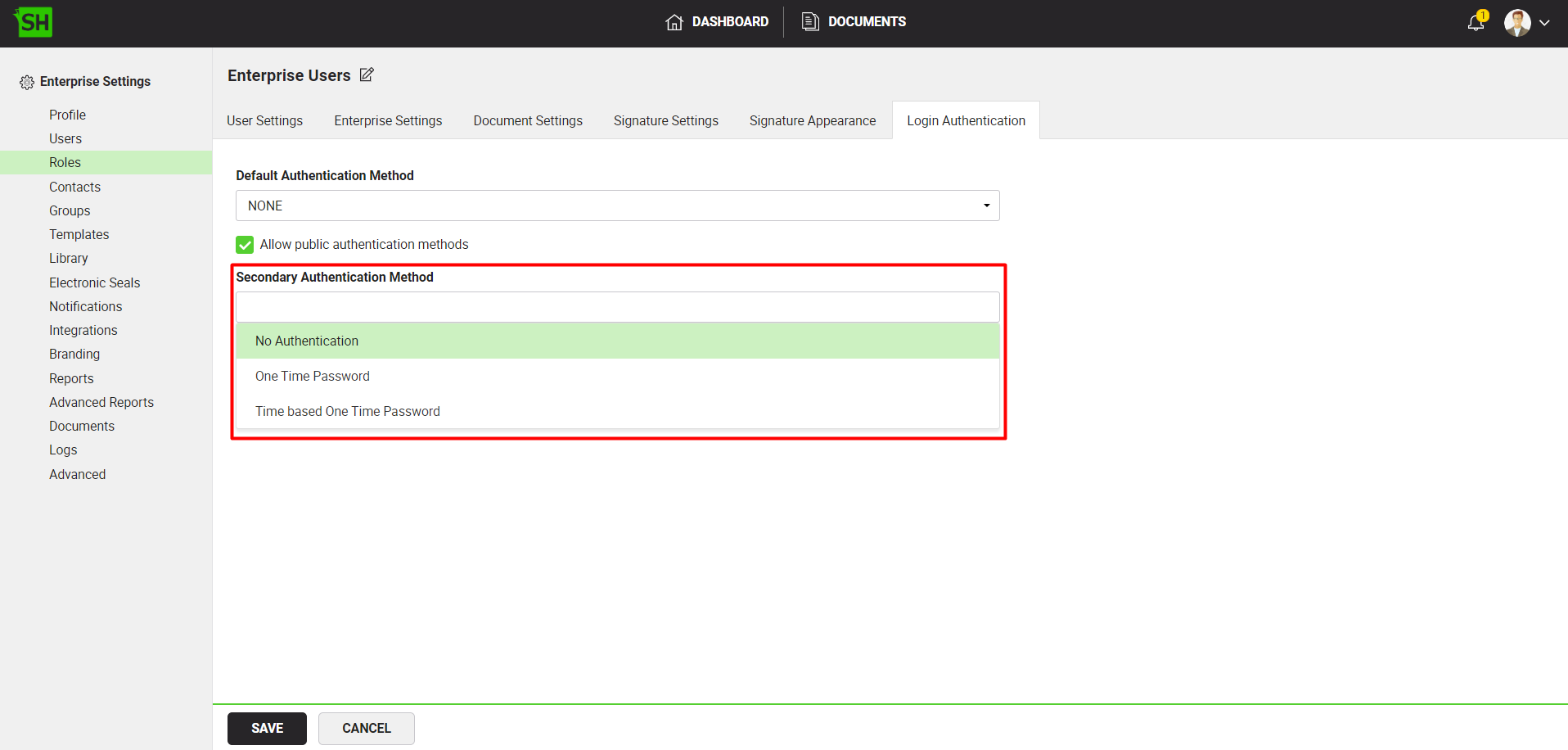
|
|
To set up, the user can either scan the "QR Code" or manually input the "Manual Key" in the Authenticator app. Once the registration is successful, the user can provide the automatically generated Time based One Time Password from the Authenticator app to SigningHub in order to proceed. The list of recovery codes included in the configuration email can be used in place of a Time based One Time Password, once each recovery code, to regain access to your SigningHub account, in case you lose access to your mobile device. It is advised to save the recovery codes in a safe place. The user can however, regenerate a new list of the recovery codes from the Manage Two Factor Authentication (2FA) option. In case enterprise user loses access to your mobile device and recovery codes, or have used all of the recovery codes, you can ask your enterprise admin to reset the two factor authentication (2FA) against your account. |
- Authentication:
- Once a secondary authentication method has been configured for login, the user will be prompted for secondary authentication upon login, after primary authentication.
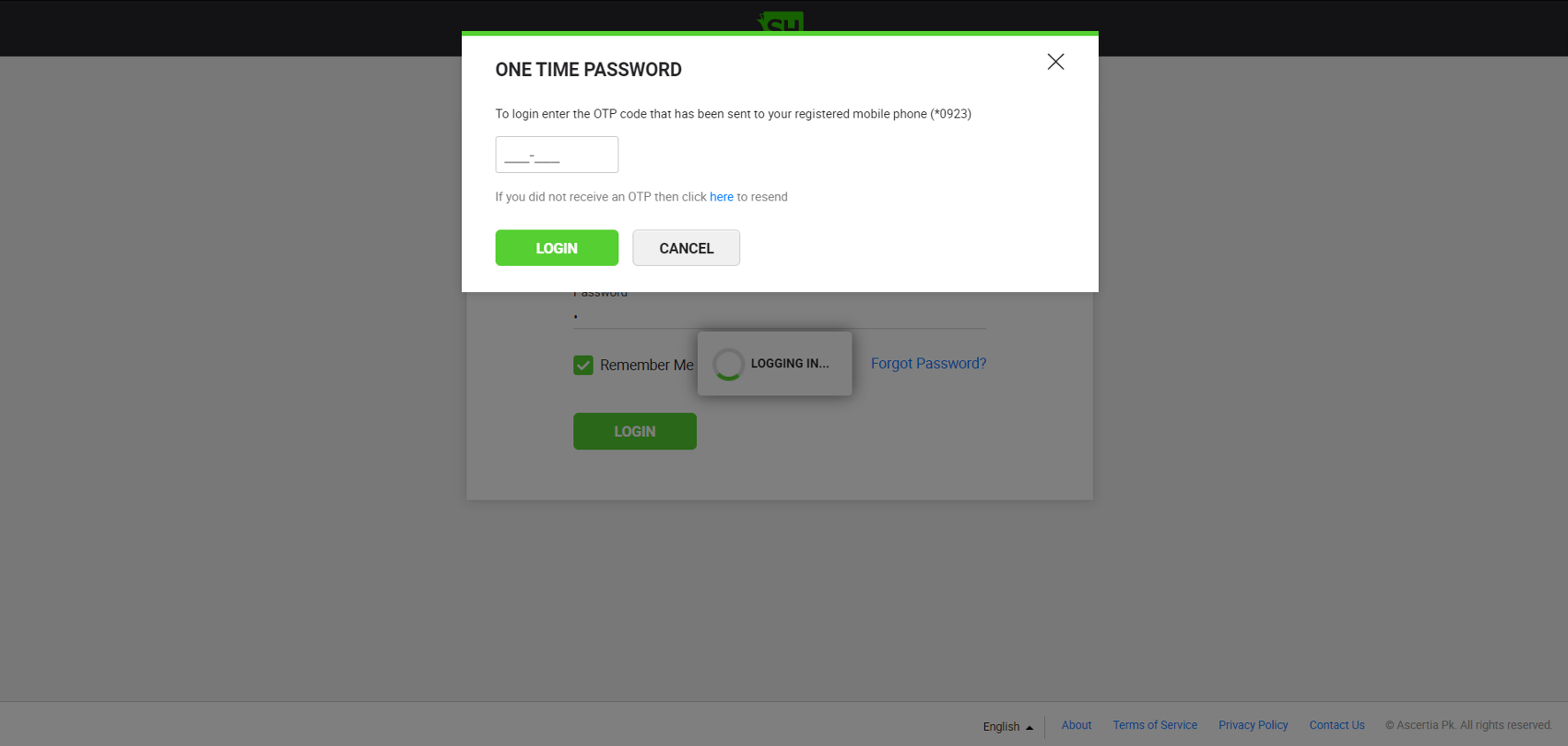
- Document Access Authentication
- Configuration:
To see in detail, how to configure document access authentication for a workflow in SigningHub, click here.
Make the following configurations to a workflow in SigningHub Web:
- From the "Set Access Security" dialog, check the "Document Access Authentication", and from the following options choose either "OTP Authentication" or "Time based One Time Password".
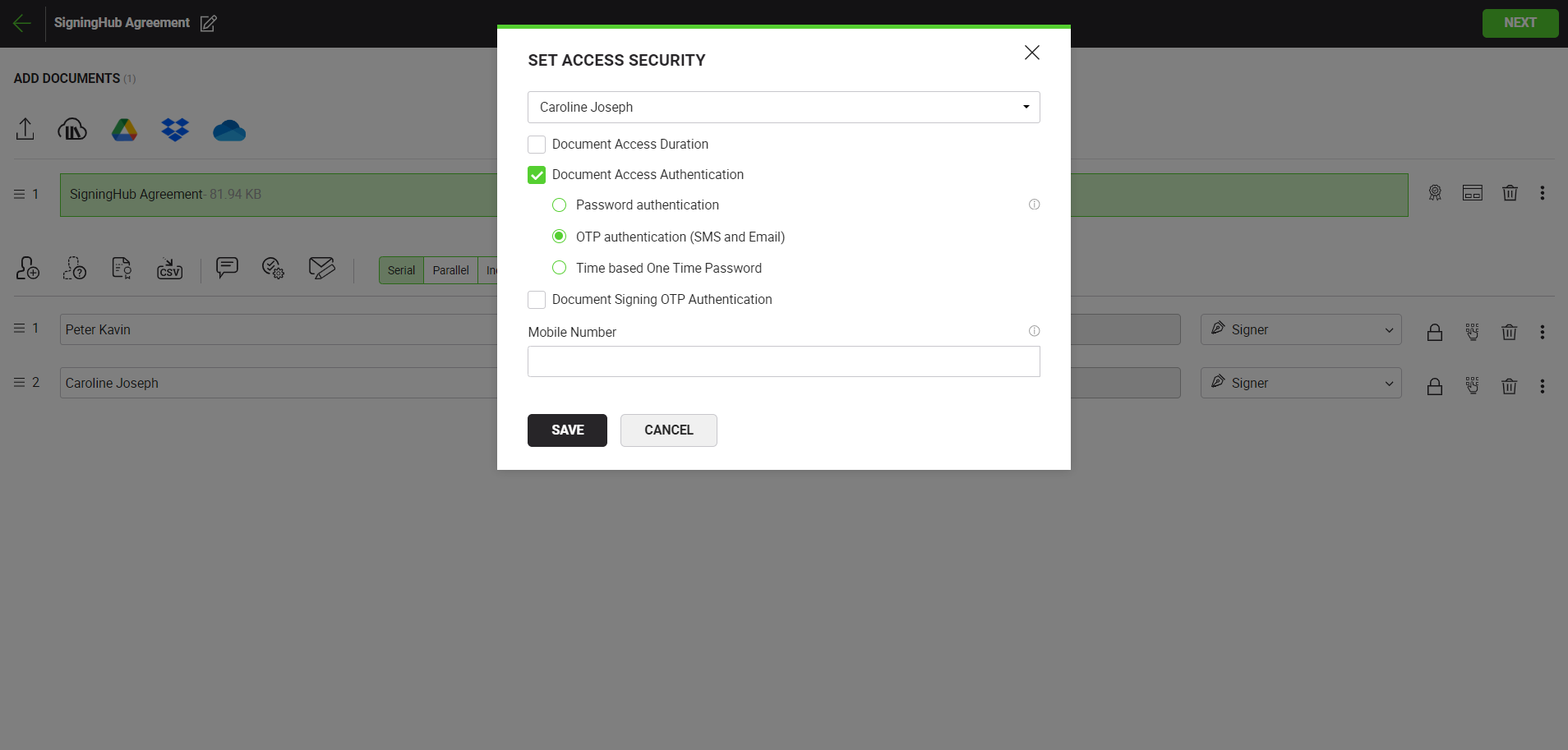
|
|
To set up, the user can either scan the "QR Code" or manually input the "Manual Key" in the Authenticator app. Once the registration is successful, the user can provide the automatically generated Time based One Time Password from the Authenticator app to SigningHub in order to proceed. The list of recovery codes included in the configuration email can be used in place of a Time based One Time Password, once each recovery code, to regain access to your SigningHub account, in case you lose access to your mobile device. It is advised to save the recovery codes in a safe place. The user can however, regenerate a new list of the recovery codes from the Manage Two Factor Authentication (2FA) option. In case enterprise user loses access to your mobile device and recovery codes, or have used all of the recovery codes, you can ask your enterprise admin to reset the two factor authentication (2FA) against your account. |
- Authentication:
- Once a document access authentication has been configured for a workflow, the user will be prompted for authentication upon opening the document.

- Document Signing Authentication
Document signing authentication can be classified into three different categories; Signing Server-level Authentication, Recipient Permission-level Authentication, and Field-level Authentication.
- Signing Server-level Authentication
- Configuration:
To see in detail, how to configure a secondary authentication method against a signing server in SigningHub, click here.
Make the following configurations to the user role settings SigningHub Web:
- In the "Authentications" section, choose either "One Time Password" or "Time based One Time Password (TOTP)" as the "Secondary Authentication Method".
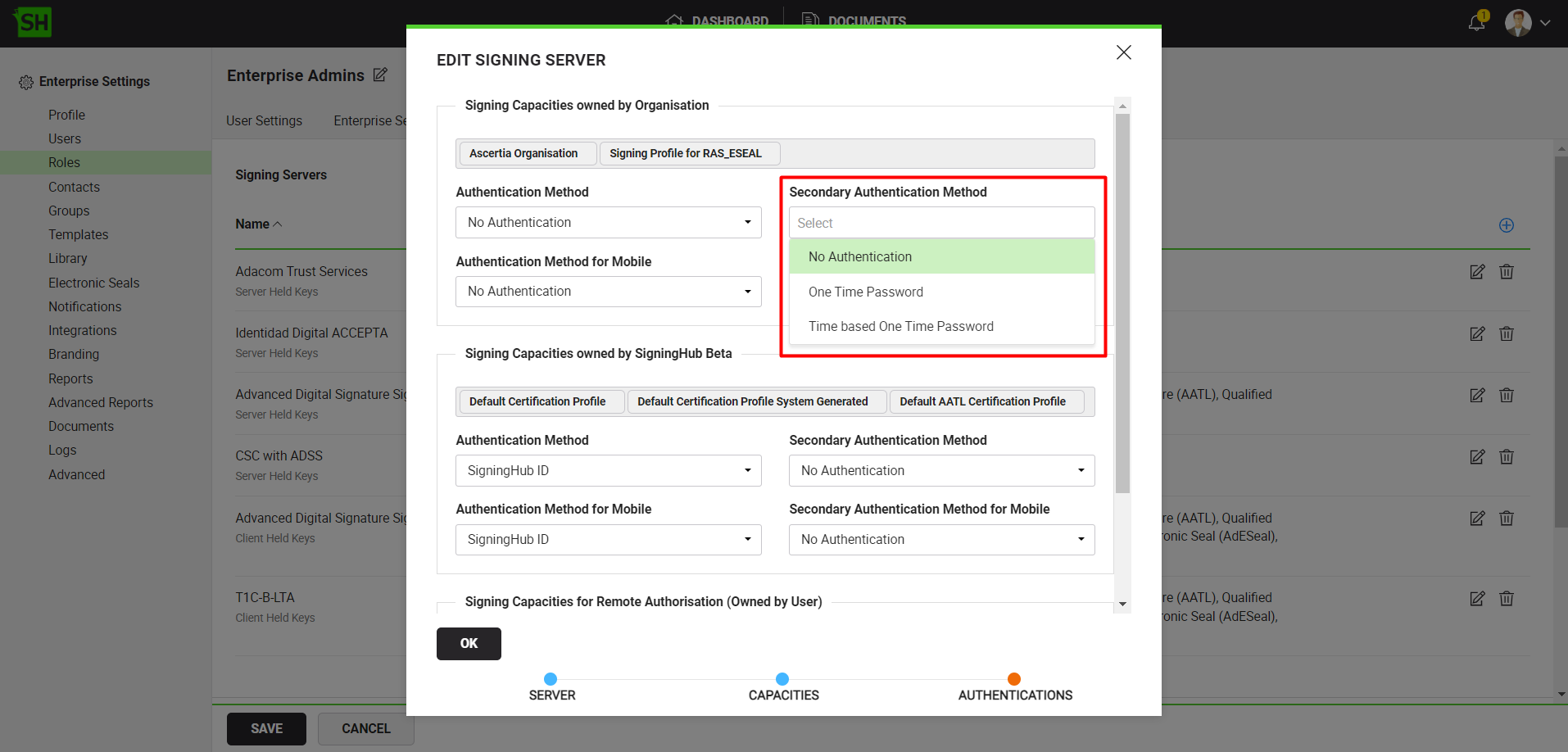
|
|
To set up, the user can either scan the "QR Code" or manually input the "Manual Key" in the Authenticator app. Once the registration is successful, the user can provide the automatically generated Time based One Time Password from the Authenticator app to SigningHub in order to proceed. The list of recovery codes included in the configuration email can be used in place of a Time based One Time Password, once each recovery code, to regain access to your SigningHub account, in case you lose access to your mobile device. It is advised to save the recovery codes in a safe place. The user can however, regenerate a new list of the recovery codes from the Manage Two Factor Authentication (2FA) option. In case enterprise user loses access to your mobile device and recovery codes, or have used all of the recovery codes, you can ask your enterprise admin to reset the two factor authentication (2FA) against your account. |
- Authentication:
- Once a secondary authentication method has been configured against a signing server, the user will be prompted for authentication at the time of signing.

- Recipient Permission-level Authentication
- Configuration:
To see in detail, how to configure recipient permission-level signing authentication for a workflow in SigningHub, click here.
Make the following configurations to a workflow in SigningHub Web:
- From the "Set Access Security" dialog, check the "Document Signing OTP Authentication", and from the following options choose either "OTP Authentication" or "Time based One Time Password".
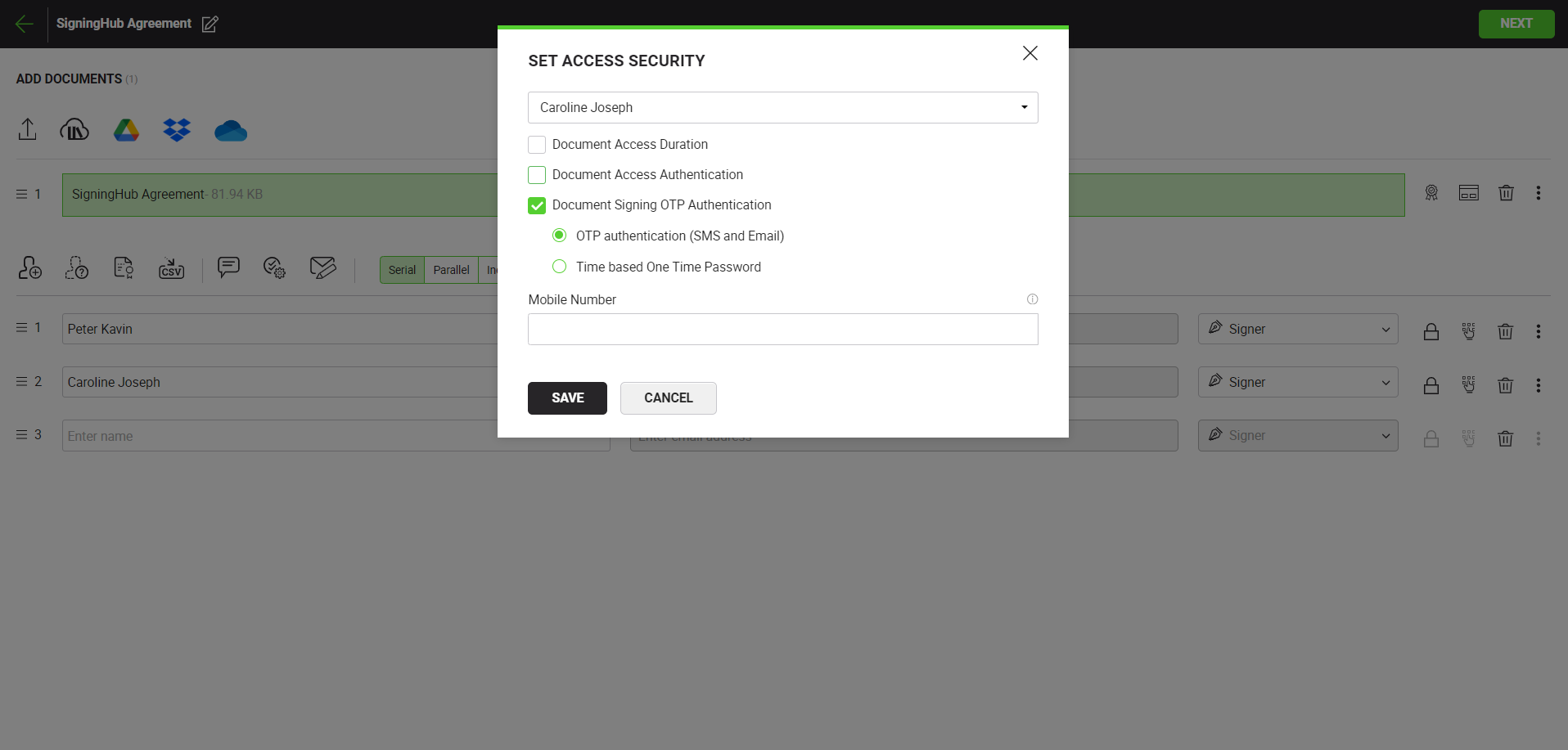
|
|
To set up, the user can either scan the "QR Code" or manually input the "Manual Key" in the Authenticator app. Once the registration is successful, the user can provide the automatically generated Time based One Time Password from the Authenticator app to SigningHub in order to proceed. The list of recovery codes included in the configuration email can be used in place of a Time based One Time Password, once each recovery code, to regain access to your SigningHub account, in case you lose access to your mobile device. It is advised to save the recovery codes in a safe place. The user can however, regenerate a new list of the recovery codes from the Manage Two Factor Authentication (2FA) option. In case enterprise user loses access to your mobile device and recovery codes, or have used all of the recovery codes, you can ask your enterprise admin to reset the two factor authentication (2FA) against your account. |
- Authentication:
- Once a recipient permission-level signing authentication has been configured for a workflow, the user will be prompted for authentication at the time of signing.
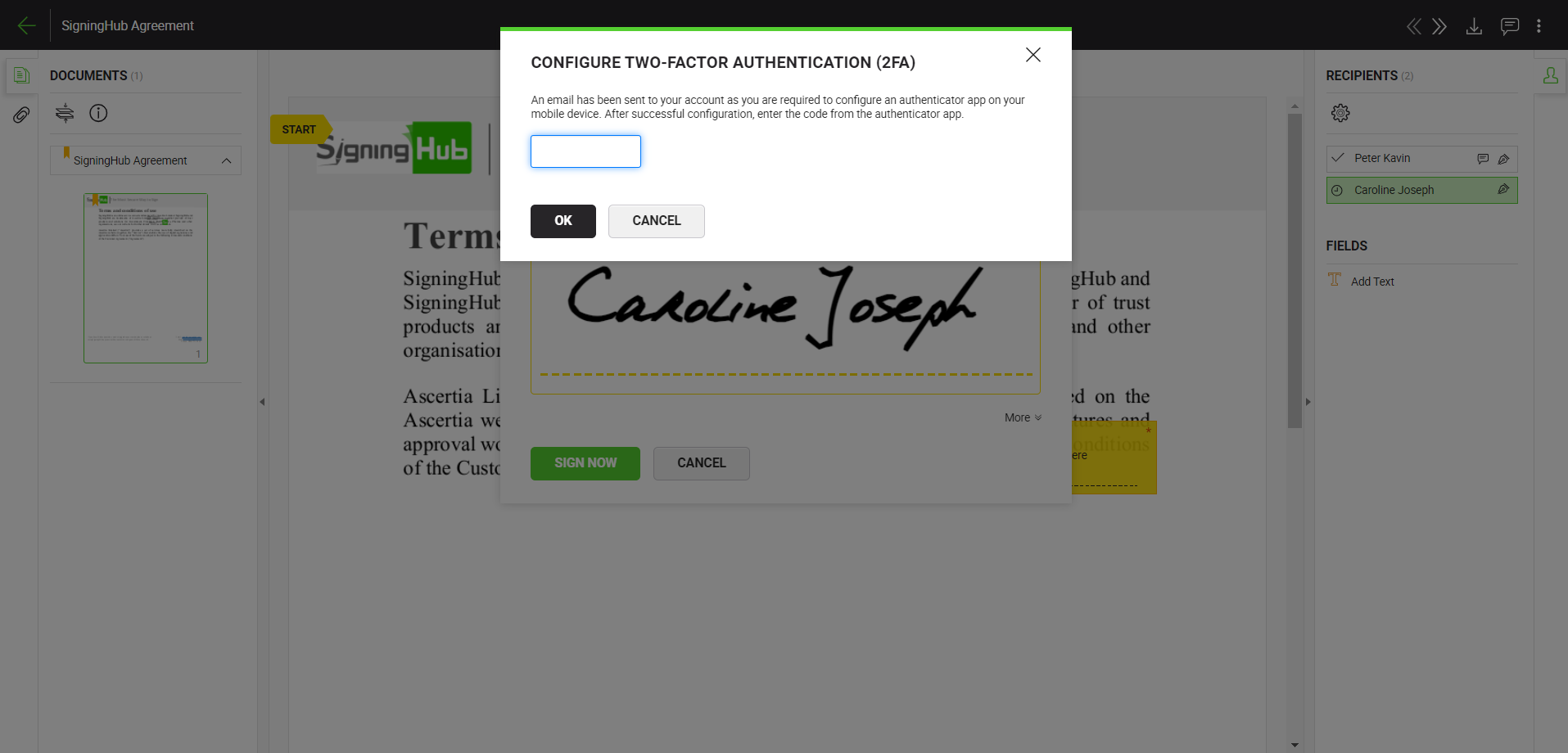
- Field-level Authentication
- Configuration:
To see in detail, how to configure a field-level authentication for a signature field in SigningHub Web, click here.
To see in detail, how to configure a field-level authentication for an in-person signature field in SigningHub Web, click here.
Make the following configurations to a signature/in-person signature field in SigningHub Web:
- From the "Edit Signature/In-Person Field" dialog, enable "Authenticate signer via OTP" and from the following options choose either "OTP Authentication" or "Time based One Time Password".
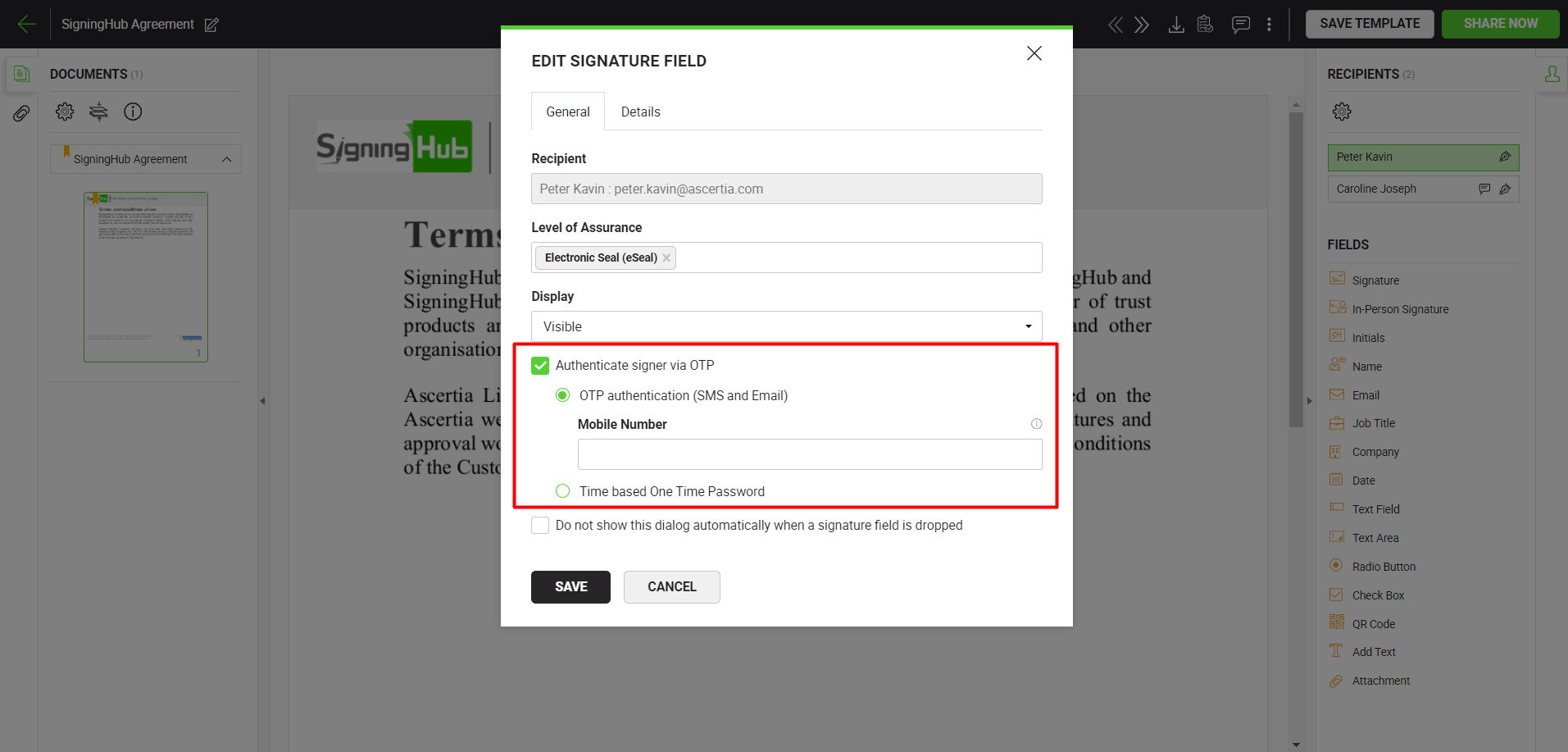
|
|
To set up, the user can either scan the "QR Code" or manually input the "Manual Key" in the Authenticator app. Once the registration is successful, the user can provide the automatically generated Time based One Time Password from the Authenticator app to SigningHub in order to proceed. The list of recovery codes included in the configuration email can be used in place of a Time based One Time Password, once each recovery code, to regain access to your SigningHub account, in case you lose access to your mobile device. It is advised to save the recovery codes in a safe place. The user can however, regenerate a new list of the recovery codes from the Manage Two Factor Authentication (2FA) option. In case enterprise user loses access to your mobile device and recovery codes, or have used all of the recovery codes, you can ask your enterprise admin to reset the two factor authentication (2FA) against your account.
|
- Authentication:
- Once a field-level authentication authentication has been configured, the user will be prompted for authentication at the time of signing.
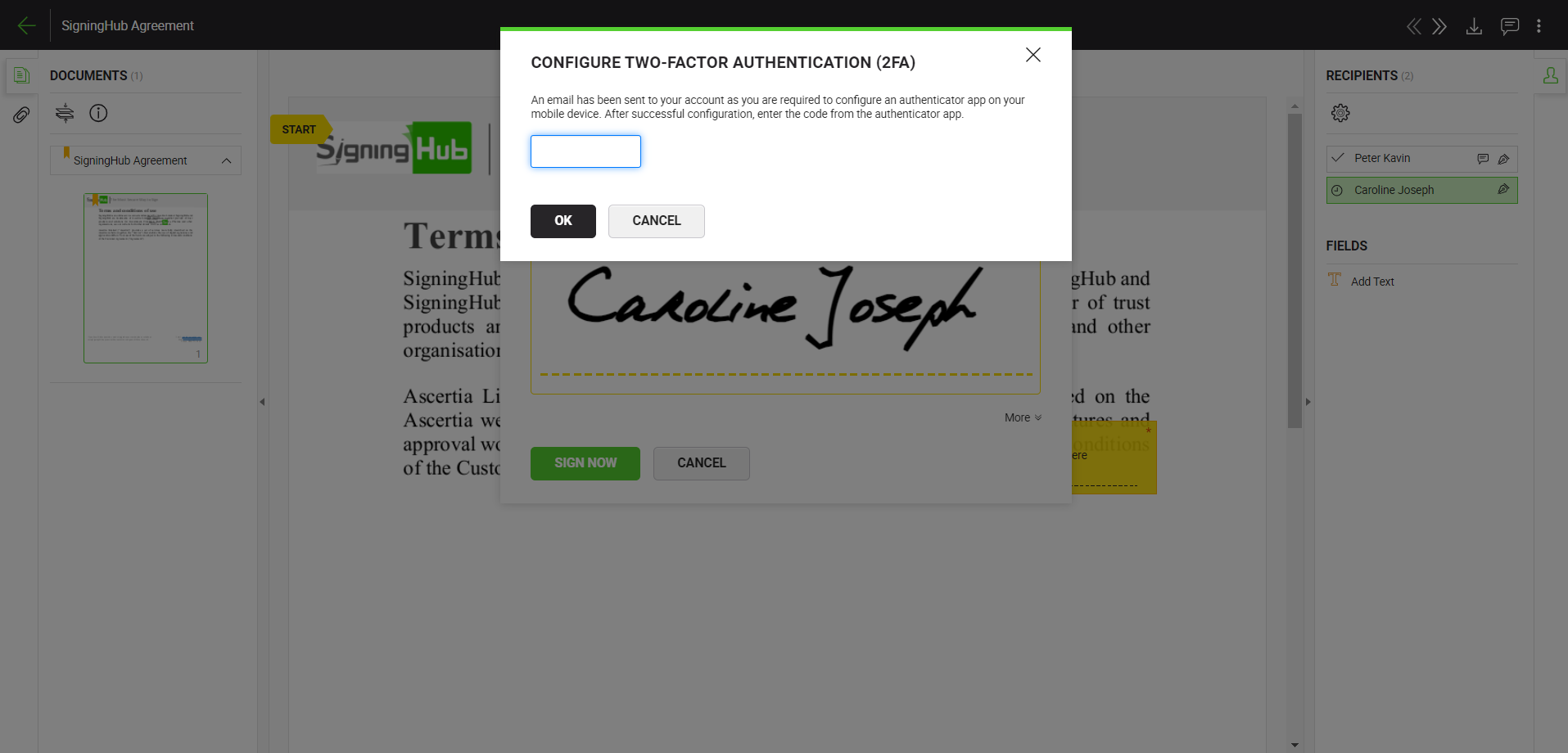
- OTP Preference
The following OTP preference will be followed while signing, in case of configuration of Signing Server-level Authentication, Recipient Permission-level Authentication, and Field-level Authentication.
|
Field-level Authentication |
Recipient Permission-level Authentication |
Signing Server-level Authentication |
OTP preference |
|
No |
No |
No |
- |
|
Yes |
Yes |
Yes |
Field-level OTP |
|
Yes |
No |
No |
Field-level OTP |
|
Yes |
Yes |
No |
Field-level OTP |
|
Yes |
No |
Yes |
Field-level OTP |
|
No |
Yes |
No |
Recipient Permission-level Authentication |
|
No |
Yes |
Yes |
Recipient Permission-level Authentication |
|
No |
No |
Yes |
Signing Server-level Authentication |
See Also
- XML Signing
- Word Document Signing
- Electronic Seal Signing
- eID Easy Signing
- CSC Signing
- Remote Authorisation Signing (RAS)
- Signing using Policy OID
- Local Side Signing using T1C Server
- Local Side Signing using ADSS Server
- Signing Based on National ID Validation
- Signing via Signature Pad
- Signing Behaviour w.r.t Signature Appearance




